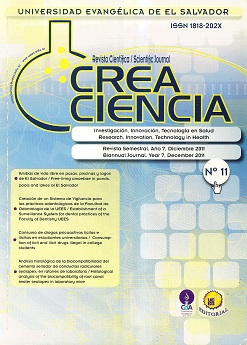Amibas of free life in pools, pools and lakes of El Salvador
DOI:
https://doi.org/10.5377/creaciencia.v0i11.8142Keywords:
Amibas of the free life (AVL), water reservoirs, chlorinated pools, natural pools, unchlorinated pools, El SalvadorAbstract
In this work, 60 water samples from 30 sites in the Salvadoran territory where water reservoirs used by the population for fun are located.
The identification of each sample included: date of collection, location of the site, surface or depth, and chlorinated or unchlorinated condition.
Each sample was sedimented and this was studied between foil and lamella, using 10X and 40X microscope objectives, looking for mobile forms of amoebas.
Additionally, four agar or agar plates seeded with live or dead Escherichia coli were seeded from the sediment.
Cultures were examined using 4X objective of the microscope. Fresh preparations were made from the colonies and observed under a microscope with 10X and 40X objectives.
Preparations that showed amoeba trophozoites were fixed with PVA (polyvinyl alcohol) and stained with trichrome staining. AVL (free-living amoeba) were considered trophozoites that had two or more of these characteristics: size from 13 to 30 micrometers, rounded pseudopods, and nucleus with a prominent cariosome surrounded by a clear halo.
AVLs were found in two water samples taken from the bottom of pools with chlorinated water, and in a sample taken from the bottom of another pool of non-chlorinated water.
Downloads
582
Downloads
Published
How to Cite
Issue
Section
License
© Crea Ciencia
Declaration of originality and assignment of rights
The article must be sent with a declaration of originality, responsibility and assignment of rights of copy of the manuscript, scanned and signed by the author or by one of the authors when the authorship is collective (designated author), stating that the text has not previously published in printed or electronic format, which will not be presented to any other media before knowing the decision of the journal Crea Ciencia and that, if accepted for publication, the authors transfer the copyrights in all forms and media known. At the end of six months of the publication, the text can be shared in another magazine citing the first version of the article published in Crea Ciencia and recording its number and volume. If the article is not published, the UEES agrees to return the rights enunciated to their authors.

Crea Ciencia articles are published in open access and licensed under a Creative Commons Attribution-NonCommercial 4.0 International License.

